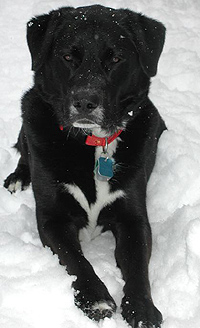St. John's water dog: Difference between revisions
JuliusNero (talk | contribs) how is that redundant? |
Undid revision 285977005 by JuliusNero (talk) |
||
| Line 25: | Line 25: | ||
==Extinction== |
==Extinction== |
||
[[Image:St johns dogs pic.jpg|thumb|350px|right| The last two known |
[[Image:St johns dogs pic.jpg|thumb|350px|right| The last two known St. John's Dogs, photographed in rural Newfoundland.]] |
||
The St. John's Dog was made extinct in its homeland by a combination of two factors. In an attempt to encourage sheep raising, heavy restrictions and taxes were placed on dog ownership during the 1800s. Also their main overseas destination, the UK, imposed rigorous long-term [[quarantine]] on all imported animals, especially dogs (1885) as part of the eradication of [[rabies]]. However, in both Newfoundland and the Maritime provinces, there are still large black [[mixed-breed dogs]] with many characteristics of the original St. John's dog. |
The St. John's Dog was made extinct in its homeland by a combination of two factors. In an attempt to encourage sheep raising, heavy restrictions and taxes were placed on dog ownership during the 1800s. Also their main overseas destination, the UK, imposed rigorous long-term [[quarantine]] on all imported animals, especially dogs (1885) as part of the eradication of [[rabies]]. However, in both Newfoundland and the Maritime provinces, there are still large black [[mixed-breed dogs]] with many characteristics of the original St. John's dog. |
||
Revision as of 09:13, 9 May 2009
| St. John's Water Dog | |
|---|---|
 Nell, a St. John's Water Dog circa 1856. | |
| Origin | Newfoundland |
| Breed status | Extinct |
| Dog (domestic dog) | |
The St. John's Water Dog, also called the St. John’s Dog, was a dog breed from Newfoundland. Little is known of the breeds that went into its creation.
This breed is the ancestor of the modern Retrievers; including the Flat Coated Retriever, the Chesapeake Bay Retriever, the Golden Retriever, and the Labrador Retriever. The St. John’s Dog was also the founding breed of the large and gentle Newfoundland dog, likely as a result of breeding with mastiffs brought to the island by the generations of Portuguese fishermen who had been fishing offshore since the 1400s.
During the 19th and early 20th century, St. John's Dogs were exported from Newfoundland to England. These dogs were cross-bred with other breeds to create the Retrievers.

Appearance and Characteristics
St. John's Dogs were medium-sized, strong, and stocky – more closely resembling modern English labs than American style. They had characteristic white patches on the chest, chin, feet, and muzzle. This coloration occasionally manifests in modern labs as a small white chest patch, or a few stray white hairs on the feet. The classic tuxedo markings of the St. John's Dog commonly manifest in lab mixes.
Writings as early as the 1600s mention a hardy medium-sized black dog that accompanied Newfoundland fishermen in their boats, and retrieved distant lines or nets of fish, hauling them back to the boat. The dogs were described as having a short thick coat, rudder-like tail, high endurance, and a great love of swimming.
Extinction
The St. John's Dog was made extinct in its homeland by a combination of two factors. In an attempt to encourage sheep raising, heavy restrictions and taxes were placed on dog ownership during the 1800s. Also their main overseas destination, the UK, imposed rigorous long-term quarantine on all imported animals, especially dogs (1885) as part of the eradication of rabies. However, in both Newfoundland and the Maritime provinces, there are still large black mixed-breed dogs with many characteristics of the original St. John's dog.
The 6th Duke of Buccleuch reportedly managed to import a few St. John's dogs between 1933-1934 and continued to retain as pure a version of the breed as possible (as the Dukes do to this day[1]), but the breed continued to dwindle. The last two St. John's dogs were photographed in old age, having survived in a "very remote area",[2] but both were male, bringing the breed to an end.
References
- ^ Buccleuch Estates website - "In fact, the Buccleuch Kennel is almost unique in as much as the original pure strain has thus far been strictly maintained since the breed reached these shores in the 1830s. All Buccleuch Labradors can be traced back to those first imported dogs."
- ^ Photos here, and are also published in Richard Wolters' book "The Labrador Retriever" according to that site.
